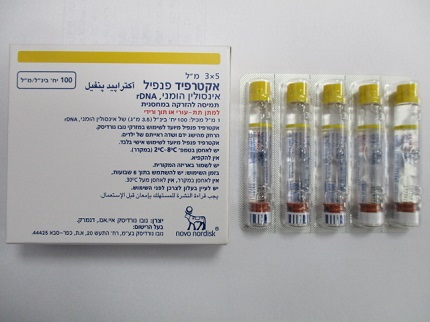Quest for the right Drug

אקטרפיד פנפיל ACTRAPID PENFILL (INSULIN (HUMAN))
תרופה במרשם
תרופה בסל
נרקוטיקה
ציטוטוקסיקה
צורת מתן:
תת-עורי : S.C
צורת מינון:
תמיסה להזרקה : SOLUTION FOR INJECTION
עלון לרופא
מינוניםPosology התוויות
Indications תופעות לוואי
Adverse reactions התוויות נגד
Contraindications אינטראקציות
Interactions מינון יתר
Overdose הריון/הנקה
Pregnancy & Lactation אוכלוסיות מיוחדות
Special populations תכונות פרמקולוגיות
Pharmacological properties מידע רוקחי
Pharmaceutical particulars אזהרת שימוש
Special Warning עלון לרופא
Physicians Leaflet
Pharmacological properties : תכונות פרמקולוגיות
Pharmacodynamic Properties
5.1 Pharmacodynamic properties Pharmacotherapeutic group: Drugs used in diabetes. Insulins and analogues for injection, fast-acting, insulin (human). ATC code: A10AB01. Mechanism of action and pharmacodynamic effects The blood glucose lowering effect of insulin is due to the facilitated uptake of glucose following binding of insulin to receptors on muscle and fat cells and to the simultaneous inhibition of glucose output from the liver. A clinical trial in a single intensive care unit treating hyperglycaemia (blood glucose above 10 mmol/l) in 204 diabetic and 1344 non-diabetic patients undergoing major surgery showed that normoglycaemia (blood glucose 4.4 – 6.1 mmol/l) induced by intravenous Actrapid reduced mortality by 42% (8% versus 4.6%). Actrapid is a fast-acting insulin. Onset of action is within ½ hour, reaches a maximum effect within 1.5–3.5 hours and the entire duration of action is approximately 7–8 hours.
Pharmacokinetic Properties
5.2 Pharmacokinetic properties Insulin in the blood stream has a half-life of a few minutes. Consequently, the time-action profile of an insulin preparation is determined solely by its absorption characteristics. This process is influenced by several factors (e.g. insulin dose, injection route and site, thickness of subcutaneous fat, type of diabetes). The pharmacokinetics of insulin medicinal products are therefore affected by significant intra- and inter-individual variation. Absorption The maximum plasma concentration is reached within 1.5–2.5 hours after subcutaneous administration. Distribution No profound binding to plasma proteins, except circulating insulin antibodies (if present) has been observed. Metabolism Human insulin is reported to be degraded by insulin protease or insulin-degrading enzymes and possibly protein disulfide isomerase. A number of cleavage (hydrolysis) sites on the human insulin molecule have been proposed; none of the metabolites formed following the cleavage are active. Elimination The terminal half-life is determined by the rate of absorption from the subcutaneous tissue. The terminal half-life (t½) is therefore a measure of the absorption rather than of the elimination per se of insulin from plasma (insulin in the blood stream has a t½ of a few minutes). Trials have indicated a t½ of about 2-5 hours. Paediatric population The pharmacokinetic profile of Actrapid has been studied in a small number (n=18) of diabetic children (aged 6–12 years) and adolescents (aged 13–17 years). The data are limited but suggest that the pharmacokinetic profile in children and adolescents may be similar to that in adults. However, there were differences between age groups in Cmax, stressing the importance of individual dose titration.

שימוש לפי פנקס קופ''ח כללית 1994
Diabetes mellitus, ketoacidosis & hyperosmolar nonketotic coma (insulin neutral)
תאריך הכללה מקורי בסל
01/01/1995
הגבלות
תרופה שאושרה לשימוש כללי בקופ'ח
מידע נוסף
